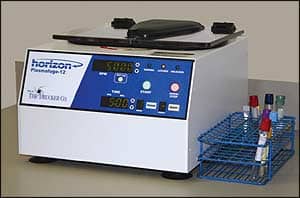By Nicholas Borgert

Here’s an old joke. How many psychiatrists does it take to change a light bulb? Just one — but the light bulb has to want to change. Wanting to change is becoming a mantra for a growing number of hospitals and laboratories seeking dramatically improved productivity and reduced spending on systems and staff.
With an assist from many of the biggest suppliers in the diagnostics industry, lab operators are focusing on process issues — including lab layout, workflow and consistency — like never before. Ortho-Clinical Diagnostics, Beckman Coulter and Olympus America Diagnostics Systems are just some of the vendors working with labs to achieve greater process excellence.
Central to process improvements is lab reorganization using Lean Thinking and incorporating Six Sigma principles in the training of lab staff (both Black Belts and Master Black Belts). The Six Sigma steps provide a statistical means — measured in deviations per million — for targeting variables in lab functions and ensuring consistency to the highest level. First associated with manufacturing, Lean Thinking has been adapted to other fields, including government, banking, real estate, general office and retailing.
Beckman Coulter approach
Attention to process and providing accepted tools to improve it has been part of the Beckman Coulter approach for the last 15 years, said Gary Conkle, Beckman Coulter’s group manager for process improvements.
“In the best sense, process is a lever — a tool you can use to improve your products,” Conkle said. “There has been too much focus on solely increasing output. I’m a big believer in measuring output, but you must focus on the entire process, thus improving efficiencies and ultimately, serving customers better.”
Conkle is the senior Beckman administrator charged with coordinating continuous process improvement (CPI) both within the company’s varied departments and as a service to Beckman’s outside customers. Many of them are in the midst of automating their operations. In his workshops and training sessions, Conkle draws on total quality management (TQM) practices as well as CPI, Six Sigma and Lean Thinking.
“The four principles for true process improvement include understanding your customer, focusing on process, teamwork and continuous improvement,” Conkle said. “We call this Global Solutions and we’ve been promoting them for 15 years.”
Old thinking holds that the only way to increase turnaround time is by buying faster instrumentation, Conkle said. “The speed of an instrument is only a small part. We look at the hospital’s entire process,” he said.
“The fact is, at a time when customer expectations continue to rise, there are only two ways to handle that. Work harder and longer — eventually that means working 24 hours a day, or improving process,” Conkle said.
According to Conkle, process improvement principles are as applicable to a one-bed hospital or storefront doctor’s office as they are to high-volume labs and the largest hospitals. Recent Beckman clients have included the University of Kansas Medical Center and a San Diego area hospital that was relocating its laboratory operation from one wing of the facility to the other — without interrupting its day-to-day full-service capabilities.
Ortho’s ValuMetrix Services
Ortho-Clinical Diagnostics began offering Process Excellence through its ValuMetrix Services Group three years ago. The program combines Lean Manufacturing, Six Sigma and Design Excellence first developed and used by Johnson & Johnson in 1998.
Not all laboratories are open to transformational change on how they set up and operate their laboratories, said Maria Foster, business director for ValuMetrix Services. Critical to success is a laboratory’s leadership and its commitment to improving financial and operational performance metrics. “The client first has to be willing to pull away from the conventional,” Foster said.
Every contract proposal anticipates costs and savings related to each recommended change. Projects are implemented by a team from ValuMetrix while transferring the knowledge to the staff of the health care provider. Foster said changing a process from batch to single piece flow is critical. “We remove operations that are non-valued added [that add cost but no value to a product or service] and maximize only that which adds value,” she said. Projects have been self-funding; typical payback periods range from three to six months.
According to Foster, lean manufacturing can be applied to operational as well as non-operational processes. She has even applied Lean Thinking and tools at home. “From my home office to the kitchen, you can evaluate the flow of your ‘product’ and evaluate the ‘current’ state,” she said. “You then apply tools such as evaluating walk patterns, your ‘tools’ set up and the product’s flow. All that is left to do is to change — remove the non-value added activities and waste to gain greater efficiencies in time and labor.”
“Science can take you a long way but we’re learning that a lab can’t just be good technically; it also has to be good operationally,” Foster said.
Savings at a Tennessee lab
The ValuMetrix program attracted the interest of West Tennessee Healthcare. WTH is anchored by 660-bed not-for-profit Jackson/Madison County General Hospital.
Leo Serrano, FACHE, executive director of laboratory services, said his lab operates a substantial outreach program. It has 30 sites including seven hospitals and physician offices and clinics; it performs more than 4.5 million billed tests annually. He said the process excellence focus at his hospital — now six months old — has emerged as the most exciting and most revolutionary concept he’s encountered in his more than 38 years of laboratory work.
The hospital became leaner in three areas. First, it was the chemistry, phlebotomy and central lab operations. The second focus involved histology and related tasks. Microbiology is the final key area tackled by four people Serrano calls the “Lean Team.” The Lean Team soon will take its knowledge beyond the lab to the hospital’s pharmacy operation and later into the hospital’s radiology operations.
Serrano was impressed by the Ortho approach. “The Ortho program is aimed only at laboratories. Because it’s knowledge transfer, they spend time teaching our team of four who came off the bench and are immersed full-time in process excellence,” Serrano said. “No continuing long-term reliance on consultants.”
And why are the biggest providers of automation systems so involved in process issues? “They have to be,” Serrano said. “They see where the lab market is headed and they don’t want to find themselves falling behind and losing out 10 years down the road.”
His facility has worked to eliminate both mandated and unnecessary waste, Serrano said. “We define mandated waste as things required by accrediting or licensing agencies, but which do not change the fit, function or form of our product. We had to get rid of what I call the 100 year rule: doing something the same way because that’s the way we’ve always done it,” he said.
His Lean Team concentrated on areas where process improvement would pay the biggest dividends. For example, changes made so far have reduced by 77 percent the time elapsed from when a specimen is collected to its arrival at his lab. The lab has converted to single-piece flow all tasks except for those that have to be batched, such as histology tissue processing.
Serrano said his hospital was facing construction of a new 60,000 square foot laboratory funded by operating revenues. But after help on process changes from the Ortho group, the new lab will accomplish its mission with only 40,000 square feet.
“Considering the construction cost savings and our other productivity advances, the ValuMetrix program has probably paid for itself four or five times over,” said Serrano.
High expectations in Minneapolis
Rick Panning, President of Laboratory Services at Fairview Health Services in Minneapolis, said using Six Sigma, lean and design excellence tools to optimize laboratory workflow and processes has gained attention just over the past few years.
His facility launched its Six Sigma program at Fairview-University Medical Center Acute Care laboratory in September 2002. Training of his lab’s and organization’s first black belt is nearly completed and certification is scheduled in June. The lab has only recently begun working on implementing lean performance principles at its Fairview Southdale Hospital facility.
Panning said the process enhancements will enable his lab to operate more efficiently, ease pressures related to staff hiring and lead to better service for patients through faster turnaround times on lab-performed testing.
“We expect a 30 percent productivity increase at Fairview Southdale,” he said. Implementing lean principles will be an intense exercise at Fairview. The hospital team will focus exclusively on two lean projects for 12 consecutive weeks.
First on the schedule is combining hematology, coagulation, chemistry and immunochemistry on to a single work cell. Previously performed at separate stations and requiring five to six staffers Monday through Friday, the new single work cell provides all the same diagnostic testing using just two clinical laboratory scientists or technicians for a part of the laboratory that produces 90 percent of the lab’s ordered tests.
Olympus process analyses
Labs seeking a less costly route to process improvement have turned to Olympus America Inc. and its Diagnostic Systems Group’s LabModel workflow analysis software. This fact-based program evaluates lab processes and workflow, then projects the efficiency of various lab layout designs and instrumentation configurations.
The Olympus LabModel software was introduced about a year ago and generated a high amount of interest, especially during workshops at the AACC Lab Automation conference in Chicago, said Terry Giacomo. Giacomo is director of new business development – financial services for Olympus. She continues to be involved in the financial module of LabModel.
Giacomo said LabModel workflow analysis was developed to help labs improve their processes without requiring a substantial up-front investment that often could approach $100,000. “We combine consulting on process innovation with software that quantitates prospective clinical and financial outcomes for various scenarios,” she said. “Labs find our expertise and the consulting service valuable, and we waive the consulting fees for labs that buy Olympus products.”
Olympus, she said, continues to work on modules that will extend LabModel workflow analysis into such areas as blood banks. The financial module she is working on, Giacomo said, measures efficiency not just in costs of equipment and products used but takes into account the labor component.
Giacomo said automation, instrument standardization and process improvements together can spur dramatic enhancements in how a lab performs and how efficient it is.
Modeling in Dallas
LabModel has proven to be a valuable addition for determining the impact of process changes at Methodist Medical Center, said Bill Johnson, Core Lab Manager at the Dallas, Texas facility. His lab performs about one million reportable tests in the chemistry area annually.
“We first used LabModel during the planning phase of renovating our laboratory in the spring of 2002,” Johnson said. “We were looking to consolidate workstations and reconfigure our laboratory. It was an inexpensive way to predictively measure how changes in personnel, layout and workflow would improve our efficiency.”
His lab is continuing to use the LabModel program as it installs an Olympus OLA 2500 System for automating its front-end operation. “We’re pretty lean and efficient to begin with, but LabModel is projecting a significant decrease in turnaround time and a slight decrease in FTEs for the front-end operation,” Johnson said.
Lab operations are more complex than instrumentation alone, Johnson said. “We’re looking at non-linear processes, such as the combinations of people you have and how they spend their time. These processes have a significant impact on laboratory efficiency and output,” he said.
Nicholas Borgert is a freelance writer in Charlotte, N.C.



